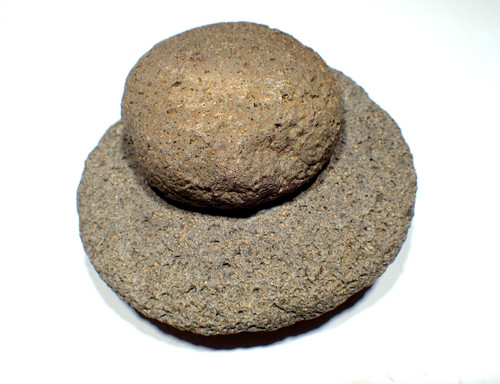Product Description
SEE MORE AFRICAN NEOLITHIC TOOLS AND ARTIFACTS
The Earth has been warming and cooling for millions of year, LONG BEFORE the first humans were on the planet. One of the most dramatic examples of climatic change in the last 10,000 years is the desiccation of what is now the Sahara desert. Prior to as recent as 3000 B.C., the South Central Sahara region in Africa was a humid lake savanna. It was home to a thriving culture of ancient humans known as the Tenerians and before them, the Kiffians. The occupation of this area by these two peoples occurred continuously from around 7700 B.C. to the drying of the Sahara in 2500 B.C..
This EXCEEDINGLY RARE set is a complete and intact grinding mill with its associated rubbing stone, from the mysterious prehistoric people of the Tenerian Culture of the South Central Sahara Desert. It is a large vesicular basalt Tenerean Neolithic grinding mill, used thousands of years ago, to grind grain for food production. These mills are the most unusual Neolithic artifact OF ANY PREHISTORIC NEOLITHIC CULTURE IN THE WORLD. No culture of the time has ever made or utilized anything quite like these objects anywhere else outside of the South Central Sahara! They are made in a few different styles but usually, in the form of massive inverted mountains, carved of a single giant stone of this rare form of basalt. Their abstract yet functional nature is so aesthetic that it is certain these objects were prized as art amongst their original creators, as well as valued as important tools of survival. The mills were used to crush and grind various grains in order to make bread. One could say these unique mills represent some of Neolithic humans' first large portable forms of art! This specimen comes from an old French collection dated back to the 1960's - 70's.
The mill and rubbing stone are in perfect original condition. Original Saharan sand is still impacted in the orifices of the basalt. Mere words cannot explain just how rare this object is. This is one of humanity's earliest forms of functional art and it's sculptural beauty would make a statement in any interior setting when put on display. 100% ORIGINAL AS FOUND AND INTACT with NO REPAIR OR RESTORATION.
ONE OF THE PRIZE ARTIFACTS OF THIS CULTURE - ULTRA RARE - FUNCTIONAL AND PORTABLE PREHISTORIC ART!
These mills represent the foundation of early Neolithic humans first transitioning from hunter / gatherer to farmer, in Central Africa. As rare if not MORE, than Cycladic art that is from a later time and routinely sells for in the millions of dollars in all major auction houses. Easily considered an investment piece of prehistoric functional art, and for such a modest price in light of its scarcity.
On a dinosaur fossil-hunting expedition in 2000 by a team of scientific explorers led by Paul Sereno, a paleodune and ancient lakebed site was discovered that yielded over 200 ancient burials of Kiffian and Tenerian people. The scientific findings showed that this region was once a humid lake region that was home to these hunter-fisher-gatherer people. The area became known as the "Green Sahara" for its once fertile and habitable landscape. Noted paleontologist, Dr. Paul Sereno, famous for other Saharan dinosaur discoveries, shot into the archaeological spotlight with his discovery of the ancient lakebed cemetery at Gobero in Niger in the year 2000. Interred in the many burials were numerous stone tools, ceramics, shells, beads and bone harpoons typical for the lifestyle of these ancient people of the Green Sahara.
In the final Pleistocene and early Holocene Periods around 10,000 years ago, the South Central Sahara Desert was once a highly favorable environment for hunters, gatherers and pastoralists. Freshwater lakes existed between the dunes in what is now the Tenere region, Lake Chad was eight times its current size, the highlands supported Mediterranean forest trees, and a diverse variety of both large and small fauna flourished there. The slow drying out process of the Sahara, began 7,000 years ago and ended 4500 years ago resulting in the barren conditions that exist to this day. As we progress through time from the end of the Pleistocene towards the end of the Neolithic Period there, we see humans relying more on meat from raised animals as opposed to hunted animals that once roamed wild in the formerly Green Sahara.
 US DOLLAR
US DOLLAR
 EURO
EURO
 AUSTRALIAN DOLLAR
AUSTRALIAN DOLLAR
 CANADIAN DOLLAR
CANADIAN DOLLAR
 POUND STERLING
POUND STERLING
























